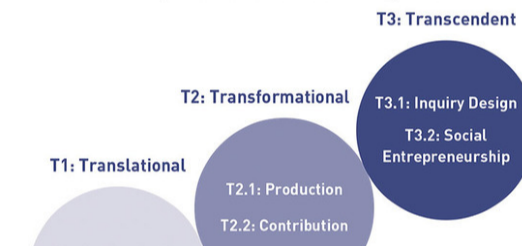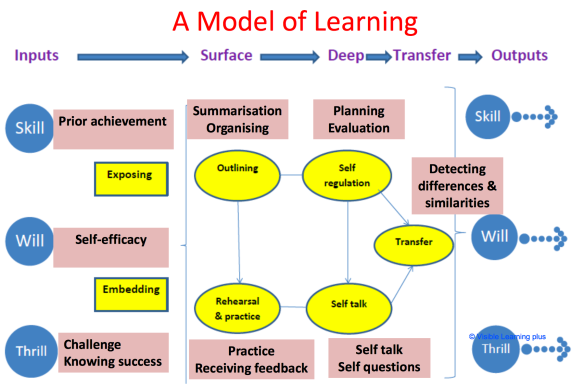Hattie and Magana: Strange Bedfellows for Technology Innovation

After following John Hattie’s work down the rabbit hole, I purchased a copy of Dr. Sonny Magana’s book, Disrupting Classroom Technology. The book outlines the need for educational frameworks, and offers a three-tiered model. Let’s take a quick look.
Of course, I’m still learning and working through my shock about Hattie’s points regarding Problem-Based Learning, which has an effect size of .35 and fails to accelerate student growth in one calendar year.
Dr. Sonny Magana’s T3 Framework for Innovation
So what are the three tiers of Dr. Mangana’s T3? The three tiers include:
Here’s my quick summary, imperfect as it probably is:
T1: Translational Tech Use: This involves using technology to improve efficiency or accuracy, and/or increase quantity or quality. This tier focuses on Automation and Consumption. It seems equivalent to Substitution and Augmentation in the SAMR model. As you can imagine, the tools-heavy focus that characterizes the typical presentations one sees that focus on “60 tools in 60 minutes.” It’s all about the tools.
T2: Transformational Tech Use: Substantive disruption or changes in either the structure of the task itself, the role of the individual engage in the task, or the impact of the task on those who perceive the object of the task. From my perspective, this corresponds to SAMR Modification/Redefinition.
However, this also appears to include tracking student progress, providing feedback reminiscent of integrated learning systems (ILSs). Fortunately, Magana specifically writes against that type of tech use. He may be referring to better student achievement progress monitoring systems.
T3: Transcendental Tech Use: In this tier, educators engage students with an ill-structured problem. The use of “ill-structured problem” is code for Problem-Based Learning (PBL). Service learning falls into this as well. Social entrepreneurship that results in generating social good and generating value. 3D printing, coding, design thinking, makerspaces all fall into this level of tech use.
A Quick Review
Wondering what I thought of the Dr. Magana’s book? It was a quick look at much of what has happened in the past for edtech folks in schools. Dr Magana’s examples (e.g. iEARN) took me on a trip down memory lane. Not surprising, of course. One point that stuck with me is how much the idea of technology as a tool to enable activities NOT possible without it appeared. Many of the examples, the writing of the T3 framework reminded me of SAMR’s levels. I found myself wondering how much the T3 framework relied upon TPACK and SAMR to get it started. One of the key contributions Magana makes is the frameworks. You can find those tables and frameworks online. Or, check out the following:
I’ll be sharing my notes from reading in a series of blog posts, so stay tuned.
Shocking Correlations
Having read how Hattie’s assessment of problem-based learning to have d<.40 effect size, imagine my shock as I read about the importance of presenting students with ill-structured problems:
Life problems are messy, and they require critical and creative thinking, communication, collaboration, deep consideration, and collective contribution.
Future learning readiness means having the facilities, disciplines, and mindsets to effectively frame new complex problems, investigate them, and apply the principles of scientific inquiry to design new pathways of contributive knowledge generation. This means that, in addition to mastering current learning problems, students need to develop the capacity to identify, investigate, hypothesize, and iteratively resolve wicked, real world problems that matter to them.
The elements in the T3) Transcendent technology use domain — T3.1) Inquiry Design, and T3.2) Social Entrepreneurship — are arguably more predictive, but are grounded in sound learning theory, learning science, research, and experience. (Source: Dr. Sonny Magana in Three Domains of Educational Technology: Part 3)
Of course, given that John Hattie endorsed Dr. Sonny Magana’s book from Corwin Press, I’m starting to wonder.
The Cult of Hattie
Is Hattie all that or is this just advocate for another dead-end education reform that lines the pockets of the power elite?
To believe Hattie is to have a blind spot in one’s critical thinking when assessing scientific rigour. To promote his work is to unfortunately fall into the promotion of pseudoscience. Finally, to persist in defending Hattie after becoming aware of the serious critique of his methodology constitutes wilful blindness.” Pierre-Jérôme Bergeron
Consider this perspective:
“…when flawed statistical analysis is resulting in advice that high-impact, evidence-based teaching strategies include:
- Direct Instruction
- Note Taking & Other Study Skills
- Spaced Practice
- Feedback
- Teaching Metacognitive Skills
- Teaching Problem Solving Skills
- Reciprocal Teaching
- Mastery Learning
- Concept Mapping
- Worked Examples
but there’s little or no impact with:
- giving students control over their learning
- problem-based learning
- teaching test-taking
- catering to learning styles
- inquiry-based teaching
…one feels a little less comfortable with the advice considering the statistical analysis of effect size is worse than merely dubious. Research can only tell us what may have happened not what is needed next as we all grapple with the future” (Source: Darcy Moore, The Cult of Hattie: Wilfull Blindness)
I find myself a bit incredulous as well. Known researchers challenge this perspective that problem-based learning has little or no impact. While I’d be inclined to say, “Maybe Hattie has something,” note that Dr. Sonny Magana also endorses problem-based learning at the transcendental level of technology, his highest tier.
Do Hattie proponents know what they are talking about? I’m not so sure. What are your thoughts?
PBL and Hattie
As you might have surmised, I’m still having trouble swallowing the idea that Problem-Based Learning (PBL) is as ineffective as the effect size suggests. Fortunately, I’m not the only one aside from Dr. Sonny Magana (who lists PBL as a T3: Transcendental Technology Use). Consider this excerpt from Bianca:
OK, so let’s look at how Project Based Learning actually authentically reflects Hattie’s mantra of ‘surface to deep to transfer’ and a movement away from ‘an over-emphasis on surface learning’. Below is a visual representation of Hattie’s model of learning (taken from this slide show from Hattie), and it is to this (and his league table of Effect Sizes – the methodology of which I acknowledge is highly problematic and has been critiqued in numerous posts such as here, here, here, here, here, and here) that I will refer to in this post. To be entirely honest (even though it hurts to admit, since I have many philosophical concerns/reservations about Hattie himself) I think this diagram is quite effective in representing the learning process – yet, in saying that, this image is nothing new or ground-breaking, and reflects many other effective representations of the learning process. A coincidence? Probably not. At this stage, if you haven’t read this BIE article on the Discover, Create, Share model of Project Based Learning, you probably should as I will be using it in my discussion.
In the above image, Hattie places ‘Problem Based Learning’ at the deep – transfer stage of learning, arguing that this is a higher order process that will only have an impact on students’ learning once they have mastered the surface learning, and a range of metacognitive skills. I have no problem with this, and would argue that no effective teacher would throw students into Problem Based Learning, without prior supporting the development of essential content knowledge and skills.
Source: https://biancahewes.wordpress.com/2017/03/25/the-skill-will-and-thrill-of-project-based-learning/
It’s clear to me I know so little and have much to learn.

